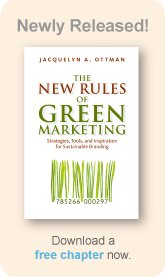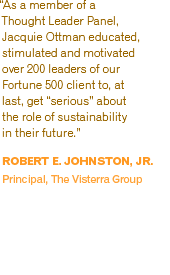The 5 Simple Rules of Green Marketing
By Jacquelyn Ottman
Design Management Review, Fall 2008
When it comes to shining a spotlight on specific sustainability issues, count on NGOs and consumer groups to target the most respected and trusted brands in the world. Overnight issues will make front pages and leaders will be pressed to make changes. The list of recent targets reads like a Who's Who of branding: Home Depot (sustainable harvested wood), Nike (child labor practices), McDonalds (Styrofoam clamshells and now obesity), and Coke (sugar and packaging). What does this all mean for your business? Simply stated, if you don't manage your business with respect to environmental and social sustainability, your business will not be sustained!
But the converse is true, too: A strong commitment to environmental sustainability in product design and manufacturing can yield significant opportunities to grow your business, to innovate, and to build brand equity. All you have to do is get the word out...right?
As with any other major business endeavor, easier said than done. Many a responsible company has run into trouble with these very same sustainability minded NGOs and consumer groups thanks to a poorly planned and crafted marketing message. Protect your company from these common pitfalls and start taking advantage of new opportunities by heeding my Five Simple Rules of Green Marketing:
1. Know your customer. If you want to sell a greener product to consumers, you first need to make sure that the consumer is aware of and concerned about the issues that your product attempts to address. Whirlpool is just one company that learned this lesson the hard way. Even after winning a $30 million "golden Carrot" prize for being first to market with a CFC-free fridge, they discovered that consumers wouldn't pay the premium because they didn't know what CFCs were - and there were no other value-added benefits.
2. Empower consumers. Make sure that consumers feel, by themselves or in concert with all the other users of your product, that they can make a difference. This is called "empowerment" and it's the main reason why consumers buy greener products. This powerful principle underlies so many campaigns laden with tips.
3. Be transparent. Consumers must believe in the legitimacy of your product and the specific claims you are making. Caution: There's a lot of skepticism out there that is fueled by the raft of spurious claims made in the "go-go" era of green marketing that occurred during the late 80s-early90s - one brand of household cleaner claimed to have been "environmentally friendly since 1884"!
4. Reassure the buyer. Consumers need to believe that your product performs the job it's supposed to do. They won't forego product quality in the name of the environment. (Besides, products that don't work well will likely wind up in the trash bin, and that's not very kind to the environment.)
5. Consider your pricing. If you're charging more for your product - and many environmentally preferable products cost more due to economies of scale and use of higher-quality ingredients - make sure that consumers can afford the premium and feel it's worth it. Many consumers, of course, cannot afford premiums for any type of product these days, much less greener ones, so keep this in mind as you develop your target audience and product specifications.
The "Rules" In Action
Let's take a look at some eco-designs (improvements over existing products), and eco-innovations (new types of products) that do a great job of winning over green consumers while grabbing market share.
Tom's of Maine
The husband and wife team of Tom and Kate Chappell created this full line of personal care products about 30 years ago. Ten or so years later, the brand broke out of the "deep green" niche to achieve distribution in CVS, Duane Reade and other mainstream drug outlets. The company is now owned by Colgate-Palmolive, (representing just one of many "deep green" brands that are increasingly being purchased by mainstream marketers. Others include: Estee Lauder's purchase of Aveda, Danone's partial purchase of Stonyfield Farm, and Unilever's acquisition of Ben and Jerry's ice cream are just a few other examples.)
The messages on the sides of the Tom's of Maine toothpaste carton are just one reason for their success in winning over green consumers. On one panel, check out the letter from Tom and Kate stating their company's mission. Signing the letter lets customers know there really is a Tom, there really is a Kate - just like there really is a Ben and there really is a Jerry, i.e., two real live people "minding the store" and staking their personal reputations on the quality of their products. (Refer to their website to see a similar letter http://www.tomsofmaine.com/about/ from Tom and Kate.)
Another panel lists all of the ingredients in the toothpaste - all natural spearmint oil for instance, and next to each ingredient is the role each of the ingredients plays in the toothpaste. There's even a third column that lists from where each ingredient is sourced. (Refer to their website for an in-depth look http://www.tomsofmaine.com/toms/ifs/at the ingredients in all Tom's of Maine products.)
This is unprecedented in the history of consumer goods! Can you do this with your product's ingredients? How many of them contain warning labels? (Crest and Colgate each do.) underscores credibility and trust For Tom's, listing the ingredients, e.g., natural spearmint oil, helps get consumers over any price barriers at the point of sale and. They are choosing a brand with natural ingredients and recognize that it must come with a price.
Toyota Prius
Toyota's Prius is likely the most successful "green" product in the world today (along with the ubiquitous CFL). And for many good reasons. First, it provides consumers with all they seek in a sedan and more - attractive styling, fuel efficiency, the ability to drive for an unlimited amount of miles only stopping for fill-ups (versus, for instance, having to stop for a
12-hour recharge if the engine were only electric). Because of the hybrid engine, the car is beloved by car enthusiasts for its quiet ride. Examine the dashboard a note a most unusual feature: a screen that lets the driver know which of the two engines is in use and how much fuel efficiency is being had at any
given moment; anecdotes report that Prius owners try to beat their previous record each time they drive!
When the car was introduced, ads focused on superior performance evidenced in a quiet ride, while supplemental ads touted its environmental bona fides. With energy prices on the rise, the Prius the pitch has shifted to superior fuel efficiency, while a crafty PR machine links the car to environmentally conscious celebrities and causes. Some owners, it is reported, even buy the car for what is being called "Conspicuous Conservation" - letting all know that they are environmentally astute. In fact, as of the second quarter of last year, "Because it makes a statement about me" was the number one reason owners said they bought their car.
Tide Coldwater
Tide Coldwater is a line extension of Tide that is helping it build brand equity and staying fresh -and green-in the marketplace. A "Life Cycle Assessment" commissioned by Procter and Gamble found that 80%-85% of the energy used to wash clothes comes from heating the water. P&G calculated that U.S. consumers could therefore save $63 per year by washing in cold water rather than warm. So, with the proviso that they could persuade consumers that coldwater washing was efficacious, they positioned the product as a way to save on energy bills.
Marketing efforts first reassured consumers of the product's efficacy. Then, on a special website designed to empower consumers, visitors could calculate the amount of energy they could save personally and in conjunction with all the others who took the same "Tide Coldwater Challenge".
Advertising showed how long major U.S. landmarks such as the Empire State Building could be lit with the energy that could be saved if all of the consumers in those cities switched to cold-water washing.
Finally, a website engaged consumers with helpful energy saving tips and resources, starting with information about switching to Energy Star certified compact fluorescent lighting. It included tips from the Alliance to Save Energy environmental group, and encouragements to "Consider buying a Different Kind of Car" namely, the Prius.
By leveraging word of mouth via the Tide Coldwater Challenge and associating with notable third parties, any barriers of skepticism were overcome. And Tide Brand found a fresh new message in step with consumers needs to control rising energy prices.
Millicare
In 2003, carpet and chemical manufacturer Milliken & Co. was in search of a new branding strategy for MilliCare, their franchise carpet and textile maintenance division. Recognizing the rapid growth of the green building industry and widespread concern over employee health, recruitment, and retention, The Moderns, New York based branding and design agency, drafted a positioning document that showed how MilliCare could own "clean" in all of its dimensions - something MilliCare's competitors weren't doing.
With the help of sustainability experts, MilliCare and The Moderns moved forward with a brand positioning that articulated the many benefits of sustainable maintenance and set up MilliCare to speak not just to facility managers, but also to architects and designers, developers, human resource professionals and CEOs. In so doing MilliCare's brand recognition was significantly enhanced nationwide. In addition to a significant increase in telephone inquiries, new business opportunities, and sales (up 30%), MilliCare has extended their national network by increased franchise partner recruitment. More partners have joined the franchise in the last two years than joined the six years prior.
The new positioning for MilliCare was captured with a new identity, tagline, stationery, training manual, presentation tools, modular marketing kit, product packaging, uniforms, vehicles, signage, franchise office design and tradeshow design.
To counter the fact that maintenance service is done at night (in absentia) and as a result is essentially invisible, various promotional initiatives were developed including sponsoring a book entitled, Green Clean, the Environmentally Sound Guide to Cleaning Your Home, a community "Clean Up" program sponsored by local Millicare franchisees, and an "on-the-ground" presence with branded vehicles which acted as a compelling billboard promotion and resulted in a significant increase in telephone inquiries and new business opportunities.
Publicity efforts on behalf of MilliCare were multidimensional and impactful. The new brand was launch at World Workplace 2004, the premier trade show for the company's primary audience of facility management professionals. Subsequent efforts have included strategic placement of bylined articles in trade magazines to support the company's thought-leader positioning; pitching feature stories in vertical market publications to introduce the concept of sustainable carpet and textile maintenance in such industries as education and long-term care; and local and regional business coverage to promote the brand and its individial franchisees.
Internal Communications. An important step in the rebranding of MilliCare was gaining the acceptance and buy-in of the organization's 80+ franchisees. A comprehensive rollout campaign included an interactive game to create intrigue, a series of launch events to provide education and a monthly e-newsletter to reinforce brand messages. As a result, the external launch saw nearly flawless implementation of brand standards, from incorporating new materials to revitalizing the entire sales process.
Method Line of Household Cleaning, Laundry and Personal Care Products
The environmental movement is about doing things differently. Method is a brand that is trying to express this "differentness" in nearly every way possible, starting with how the product looks and smells. The bottle for the dish soap (pictured) looks like an upside down teardrop. It was specifically designed by a well known fashion designer Karim Rashid so consumers would feel comfortable leaving it right at kitchen sink, helping the user project a sort of status to visitors.
The product label sports a very understated lower case "m" in a circle, with "method" also in lowercase just beneath. No splashy lettering. No flashy starbursts like those that were designed to capture consumers' attention at mainstream store shelves. What attracts consumers to this product is the distinctiveness of the package shape and the unique coloring of the product inside. This product may look expensive, but it actually sells at competitive prices at Target, Office Depot and Safeway.
Method doesn't advertise. They attract consumers via strong price value and word of mouth that is generated in a number of highly effective ways, starting with the uniqueness of the product itself. Visit their website and read how they tell visitors what they stand for: A page each is devoted to the elements of the Method "mantra": Efficacy, Safety, Environment, Design (do your brands consider design?), and Fragrance. (In-home interviews I conducted for a client recently attested to the importance of light scent to this brand's purchasing decision.) Do your brands have mantras - or simply a list of benefits or possibly just a marketing and creative strategy?
Another thing you'll find at their website is a campaign called "I Fight Dirty." (Note the "anti" tone.) This campaign empowers users to not only fight against dirt itself, but also dirty practices by industry. Thus, its captures the essence of what the brand is about from both the functional as well as emotional standpoints. (Another breakthrough.)
Refer to their website http://methodhome.com to see a sample of a newsletter that is sent to consumers who sign up. Recent issues have proffered tips on how to compost Christmas trees, locate brands of reusable diapers, save pristine beaches by fighting dumping in oceans of plastic laundry bottles. The website talks about the places where Method has been spotted - like the "Green Festival" hosted by Coop America each year. And it even gives visitors the opportunity to buy merchandise like tee shirts emblazoned with the method name! How many of your users would wear clothing with your brand's name on it? How many of you would even think to offer it?
Putting the "Rules" to Work for Your Business
To start capitalizing on the many market opportunities represented by sustainability, consider the following:
1. Think and act holistically. It is no longer enough to focus on functional benefits alone.
ASK: What are we making (product or service? Green or not?) How are we making it?
Who are we working with?
2. Take advantage of the opportunities that green marketing represents to engage consumers on an emotional level and thus, build brand equity. ASK: how can we make...our passion and vision relevant and engaging? our consumers into advocates? How can we empower consumers to make a difference by providing them with education, infrastructure, events and experiences?
3. The way you communicate will be critical to success (and will help you avoid
"greenwashing"). ASK: How to ensure that our approach is viewed as authentic?
Transparent? Are all stakeholders aware of our intentions and progress? Is our vision embedded into the fabric of our company?
4. Eco-innovation represents new ways to grow top line sales. ASK: How can we inspire consumers? What technology and partners do we need to gain access to?
5. Strive for an ideal goal of "Zero" environmental impact. Strive to eco-innovate rather than simply eco-design. ASK: What would it take to achieve zero environmental impact and still meet our consumers' needs? Can we make consumers more "responsible"? It's one thing to design better products and technologies. But at some point, industry's efforts will only go so far. Achieving "zero" environmental impact will only come about if changes in consumer behavior can be made; thus the genius of Toyota's dashboard, and websites that engage consumers in more responsible forms of behavior.



 ShareThis
ShareThis
Jacquelyn Ottman is president, J. Ottman Consulting,
a green marketing consultancy that advises businesses on strategies for
developing and marketing environmentally sustainable products and
services. She is the author of three books on green marketing. Her
latest book,The New Rules of Green Marketing, is due out
in 2010.
Contact her by email
Follow her on Twitter
Connect to
her onLinkedin
Read
her blog
Copyright© 2008 by J. Ottman Consulting, Inc.


